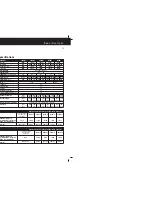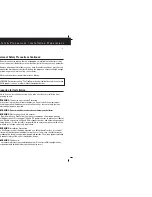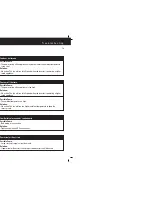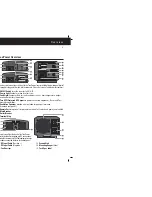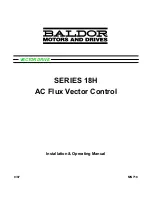
11
O p e r a t i o n
Operation
The ON/Off switch turns the TruePower Inverter to ON or to Off.
In the ON position, the Inverter /Fault LED light will illuminate Green. The TruePower begins
inverting and provides modified sine wave power.
Some appliances and tools operate using larger electric motors, tubes or capacitors
require an initial surge of power to start up. This extra surge of power required is often
called the “peak load”, “starting load” or “surge capacity”. Once such a tool or appliance
is started, it requires significantly less power to continue operation. This is commonly
referred to the “continuous load” of power.
As a rule of thumb, most often the start up or surge load of the appliance or tool will
determine if your TruePower inverter has the capability of running it. If the appliance or
tool does not start the first try, attempt switching the appliance on every 2 seconds until
the appliance turns on. If the appliance does not start after the 5th or 6th attempt, it may
require a larger surge than your inverter provides.
LED Indicators:
The two indicator lights on the front panel of the inverter illustrate the operating status
of the TruePower Inverter. See table 4 below.
Status of Indicator Lights Table
8
DC Wiring Options Continued
Figure 2)
This wiring diagram
displays a battery configuration
for Medium- Duty applications.
This configuration allows the
inverter to only draw power
from the auxiliary battery and
keeps the vehicle start battery
from being drawn upon.
To obtain sufficient battery capacity, you may need to use more than one battery. Two
identical batteries can be con to + and – to – in a parallel system, doubling capacity.
We recommend that you do not connect batteries from different manufacturers, or with
different amp-hour ratings in parallel as decreased battery life may result. See figure 3 below.
Figure 3)
Displays 2 x 12volt batteries connected
in a parallel system that doubles the capacity
and maintains the 12v voltage requirement of
your inverter. This battery bank requires a
battery charging system.
If you are using different batteries, or need to use more that two batteries, we recommend
that you set up two separate battery banks and use them alternately. Battery selector
switches are available from Marine and RV Dealers which allow the user to select
between two banks of batteries, or use both in parallel, or disconnect both banks from
the load. Please see figure 4 below.
Figure 4)
Recommended Battery
Configuration for Heavy-Duty
Applications
I n s t a l l a t i o n G u i d e l i n e s
*fuse
*fuse
When the TruePower unit is on,
the Inverter light illuminates.
The Fault light illuminates
whenever there is a battery
over-voltage fault condition (in
excess of 1/- 1volt), a
low battery protection indicator
(below 1/- .5volts), an
output overload condition
The inverter is over a safe
operating temperature.
Can run your appliances through the
Inverter from the battery.
Can not run appliances as the AC output
is disabled in the inverter mode. Clear
the fault condition. Reset the unit by
turning the ON/Off switch to Off and then
back to ON.
The inverter may need to cool off for a
period. Reduce load, duration of use if
you have been using for a longer period
of time. If it continues to be a problem,
you may need to properly size your
inverter to your application. Call our 1-
800 Service line for additional help or
service if problem persists.
Fault
Red
Power Green
Light
Color
Status
Result
negative
positive
TruePower
POS
NEG
to ground
isolator
from alternator or charger
bank #1
vehicle
battery
bank #2
battery selector switch
*For an ABYC E-11 compliant installation,
customer supplied fuse, 7" from battery
*fuse
TruePower
POS
NEG
deep
cycle
auxiliary battery
to ground
boat/vehicle battery
isolator
from alternator or charger



